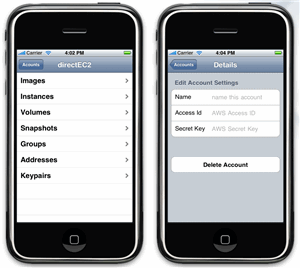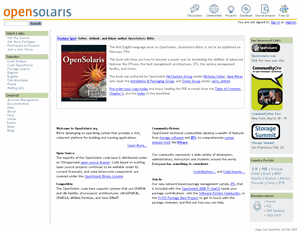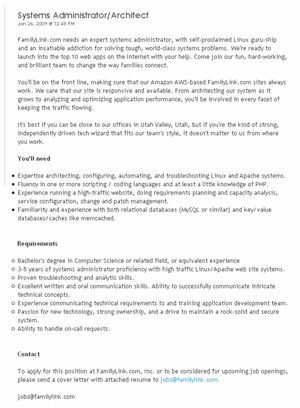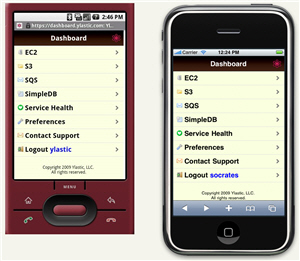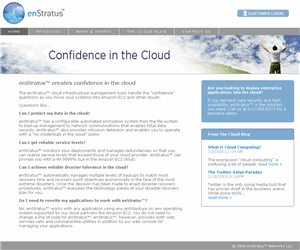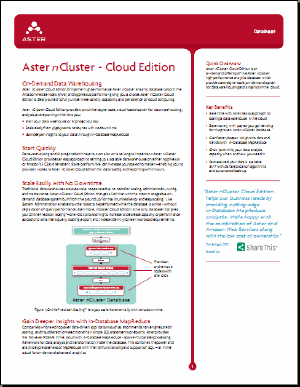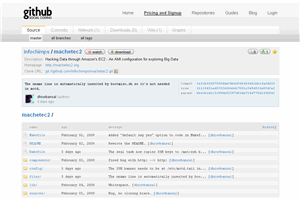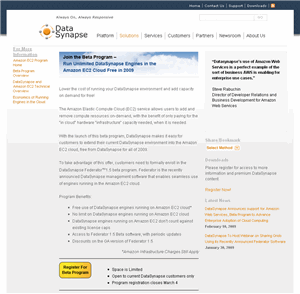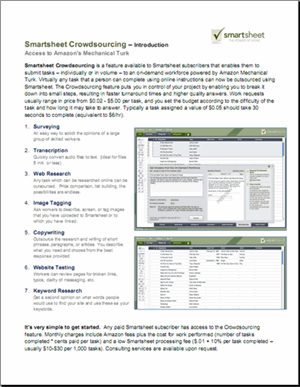AWS News Blog
AWS Links – Wednesday, February 11, 2009
|
|
As always, my inbox is simply overflowing with new and innovative AWS-powered applications. Here’s just some of what I’ve received in the last week or two: cool applications from Direct Thought, Zemanta, Jooners, Ylastic, enStratus; Solaris on EC2 from Sun; a job opening at Family Link; a Java library for SimpleDB; system software from AsterData and DataSynapse; an EC2 AMI for processing large amounts of data, and a remarkable new way to use the Mechanical Turk.
David from Direct Thought wrote to tell me that they’re working on an iPhone application to control EC2 resources — images, instances, volumes, security groups, IP addresses, and keypairs. The application supports multiple EC2 accounts and includes an AMI search feature to make it easier to find what you want in our AMI catalog.
He also told me that the application was written using an Objective-C port of his highly respected Typica library. This Apache-licensed port is called cTypica and is available from Google Code.
Andraz from Zemanta dropped me a line to let me know that they released a major upgrade and expansion of their content creation and discovery tool.
The original release of the Zemanta provided a helping hand (almost a research assistant) for bloggers, suggesting relevant links and content in real-time as the post is written. This functionality has been enhanced to allow it to recommend additional types of content, including audio, video, and maps. Zemanta takes care to recommend content that has a Creative Commons license or that has been approved for reuse by the original content provider.
The new release now extends this same helping hand to web-based email in the form of a Firefox extension which supports Gmail and Yahoo! Mail. It also adds support and recommendation for specialized content categories including books, music, technology, blogging, green, health, travel, gaming, shopping, and wine.
You can learn more by watching a pair of short and sweet screencasts. The first one shows how Zemanta works with Yahoo! Mail, simplifying the task of linking to pages on popular social networking sites while composing an email. The second one shows how Zemanta can enhance Gmail, suggesting some relevant pictures, links, and reference articles.
If you’ve ever had to plan and coordinate an event across families, teams, clubs, or other semi-formal groups, you’ll want to take a look at Jooners, especially if you need to apportion and collect money for fees, dues, or other costs from the participants.
Jooners uses a clean and straightforward wizard-based planner model to plan one-time or recurring events, coupled with the Amazon Flexible Payments Service to handle all of the payment details. There’s a helpful introductory video on the home page and a gallery of popular planners.
Rajesh from Sun wrote to tell me that the OpenSolaris AMIs for EC2 are now available for use with the US and European EC2 regions. His blog entry includes all of the important details.
This is the 2008.11 release of OpenSolaris which includes a number of new features such as new releases of the Gnome desktop, OpenOffice, and Firefox, automatic file snapshots to ZFS, the very cool-looking Time Slider, better printing, the Songbird music player, an improved package manager, and lots more.
Read the Getting Started Guide to, uh, get started. You may also want to consult the OpenSolaris AMI catalog to learn more about the available public and private (registration required) AMIs.
My friends down at Utah-based FamilyLink.com want to hire a combination Systems Administrator and Architect.
The job posting notes that “You’ll be on the front line, making sure that our Amazon AWS-based FamilyLink.com sites always work.” In a recent blog post, founder Paul Allen notes that their We’re Related on Facebook application is one of the 5 most popular, with 12.4 million daily users. Paul says that they’ve had to restrain growth in order to make sure that they have their system issues under control.
You’ll need experience designing, building, and running large-scale systems with AWS, fluency in a couple of scripting languages, and experience with a relational database and a key/value store like Memcached or SimpleDB.
Per a note in the Ylastic blog, the Ylastic dashboard for the Apple iPhone and the Google Android is now in production and available for just $10 per month. You can control EC2 instances in the US and in Europe, manage CloudFront distributions, SQS queues, S3 buckets and objects, and watch the AWS Status Health Dashboard.
Check out the pricing and the full feature list to learn more.
Minnesota-based enStratus has launched a web-based console to control the deployment of EC2-based web sites and enterprise applications. The console manages security and availability profiles based on organizational requirements, and can bring up additional load balancers, application servers, and database servers as needed. It also handles multiple levels of cloud and cloud-independent backups.
Company founder George Reese writes the Cloud Blog and is wrapping up work on an O’Reilly book called Cloud Application Architectures, currently available in a Rough Cuts edition.
SimpleJPA is an open source implementation of the Java Persistence API (JPA) for SimpleDB.
It supports ManyToOne references and OneToMany collections, both with lazy loading. It supports large objects using S3 and caches results. It also makes concurrent requests to SimpleDB to speed things up, and even supports a subset of the JPA Query language.
SimpleJPA’s caching and S3 support comes courtesy of BigCache, a simple Java API which implements an infinite shared cache on top of S3. BigCache includes come cool asynchronous methods.
Aster Data Systems just released the Aster nCluster Cloud Edition. This release brings the Aster nCluster analytic database to the EC2 cloud, greatly simplifying the process of creating a data warehouse or BI (business intelligence) project and reducing time to market. The product includes a unique in-database MapReduce processing framework; data analysis and transformation is supported inside of the database itself. There’s more info in the data sheet.
Aster Data will be hosting a webinar, next week. Titled “Data Warehousing in the Cloud”, the webinar will describe how AWS customer ShareThis was able to create a multi-terabyte data warehouse without making a heavy investment in people, time, or hardware.
A note on the InfoChimps blog, and a hallway conversation/reminder with my colleague Deepak Singh, led me to machetEC2. Described as an “AMI configuration for exploring Big Data,” machetEC2 is an EC2 AMI pre-configured with a very long list of data processing, analysis, and visualization applications atop a solid base of Python, Ruby, and Erlang tools and libraries.
You can launch this AMI and be chewing through a massive chunk of data pulled from the AWS Public Data Sets in no time flat. The next version of machetEC2 will include commands to simplify the process of creating and mounting EBS volumes containing this data.
This is your basic nuclear-powered chainsaw for heavy duty data processing!
DataSynapse has extended their DASM (Dynamic Application Service Management) product, DataSynapse Federator with support for EC2). DataSynapse customers will be able to seamlessly bridge traditional data centers and the EC2 cloud. They will be able to create development and testing grids at a very low cost. Finally, they’ll be able to use EC2 for disaster recovery, paying for capacity only as needed
Existing DataSynapse customers can register for the space-limited beta program between now and March 4th.
Seattle-based SmartSheet is a work management and collaboration tool. Using their straightforward spreadsheet-based model, you can easily enumerate and capture the tasks needed to complete a project and then assign them to partners and co-workers. Already users of EC2, S3, and CloudFront, they have now added Mechanical Turk support to the product.
In addition to assigning tasks to partners and to co-workers, you can now assign them to qualified Mechanical Turk workers on an individual or volume basis. You can now create and successfully complete projects using a workforce of over 200,000 people from over 100 countries! The new brochure suggests that this can be used for surveying, transcription, web research, image tagging, copywriting, website testing, and keyword research. The crew at SmartSheet have called this new model smartsourcing, which sounds good to me.
SmartSheet handles all of the setup, submittal, and retrieval of Mechanical Turk HITs (Human Intelligence Tasks); no coding is required. You can request multiple answers for each item, and you can monitor the results as they arrive using a unified management dashboard. Images can be attached to requests or even requested as responses. You also have the power to accept or reject answers and can even pay bonuses to the best workers. Read more about all of this in the advanced brochure.
Before you go, head over to this page and click the link labeled “Watch Overview Video” to see Smartsourcing in action. This amazing new feature is available to all paid users of SmartSheet.
And that’s all for today. If you would like your AWS-powered application to be featured here, send me some email and I’ll do my best.
— Jeff;

